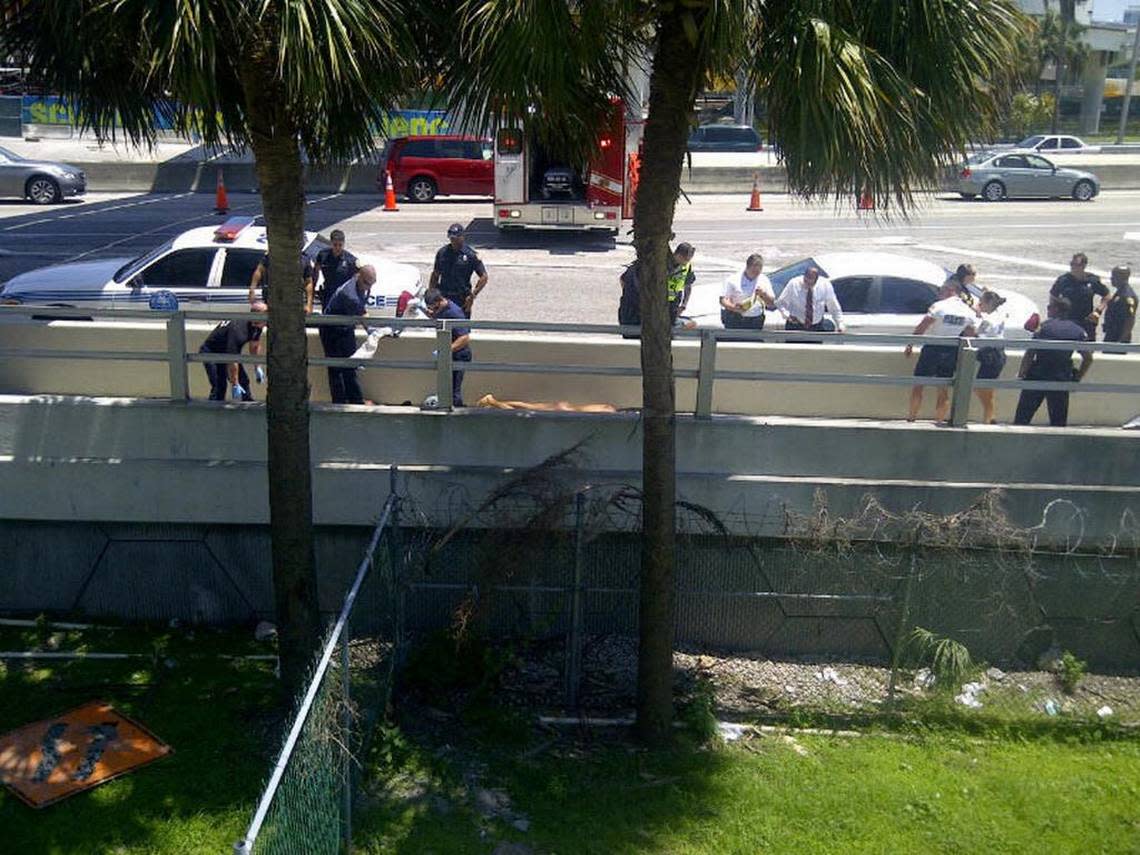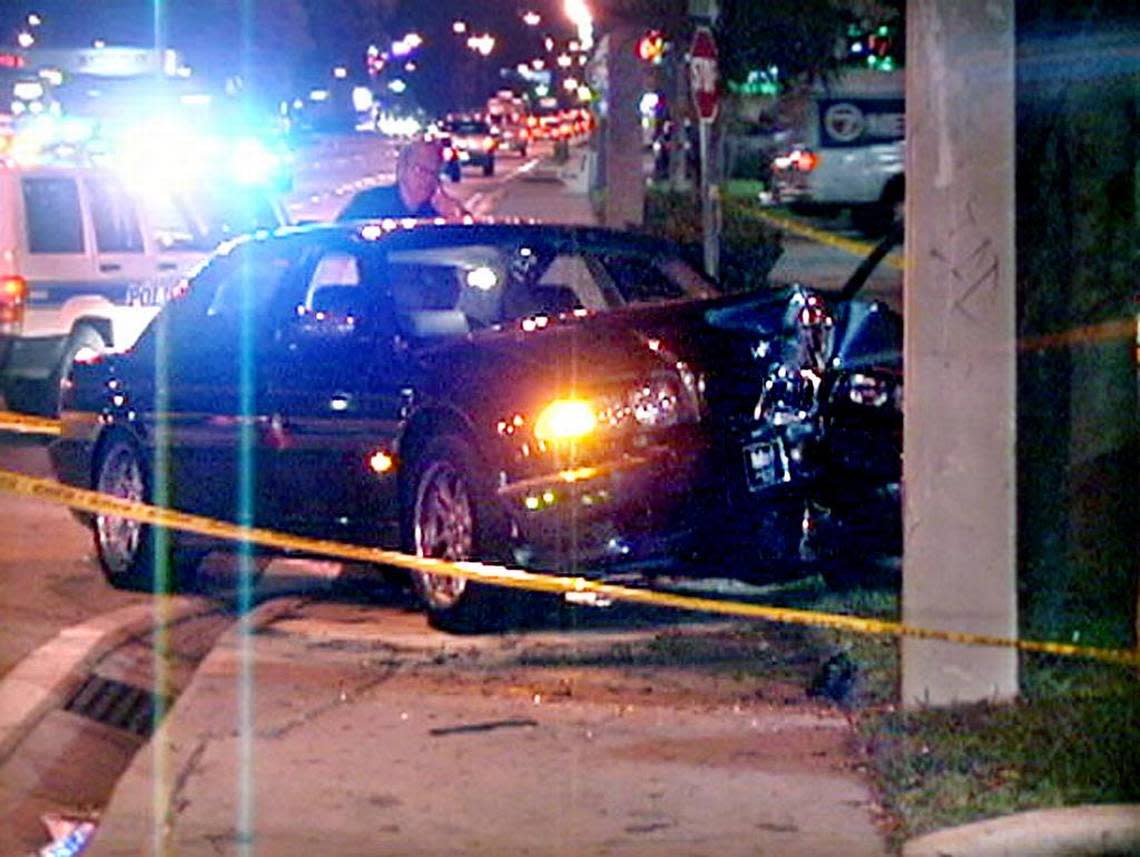How shocking were these Miami murders? We’re still talking about them years later
What goes on behind the yellow police tape? Usually, a tragedy.
But sometimes the details of a Miami-area crime are so shocking and unbelievable that they go down in local lore.
A murder shown live on Facebook. A naked killer who threw his girlfriend’s severed head at a rookie police officer. A man who chewed the face off another on a picturesque causeway. Hits on the sub king, the racing boat king and on the steps of a popular steakhouse.
Let’s take a look at some of South Florida’s most shocking crimes from the archives of the Miami Herald:
Case of the severed head
It wasn’t enough that Alberto Mesa stabbed his 18-year-old girlfriend Dina Tormos 111 times, beheaded her with a hunting-type knife and left her body inside his Miami apartment.
What Mesa, 23, took from that apartment elevated Mesa’s act to a true only-in-Miami moment: At dawn on March 2, 1985, under the Metrorail station near Southwest 33rd Court and 29th Terrace, Mesa stripped bare and leaned against a support column, clutching the severed head of the woman he had dated for six months. As police officer Derek Aycarte, 22, approached, Mesa hurled the woman’s head at the officer and shouted, “I killed her. She’s the devil!”
Mesa, who believed he was possessed, was found not guilty by reason of insanity in a non-jury trial. He was committed to the Florida Department of Health and Rehabilitative Services.
![HUSBAND AND WIFE: Derek Medina and wife Jennifer Alonso in the kind of photo Medina would often post on his Facebook page. Medina is accused of killing Alonso and posting a photo of her corpse inside their Miller Road townhouse on April 8, 2013 with the message, “Im [sic] going to prison or death sentence for killing my wife love you guys miss you guys take care Facebook people you will see me in the news.”](https://s.yimg.com/ny/api/res/1.2/Y6_yqbG_77yJeu4gY453lg--/YXBwaWQ9aGlnaGxhbmRlcjt3PTEyNDI7aD0xMTU5/https://media.zenfs.com/en/aol_miami_herald_mcclatchy_670/7d741777cf1a73ae492e3e59ae0721b4)
Case of the Facebook murder
Derek Medina, 31, a Coral Gables High 2001 graduate, lived his life on social media, but few were interested.
All of that changed on Aug. 8, 2013, when the South Miami man posted a grisly photo on Facebook: the corpse of his wife, 26-year-old Jennifer Alonso, as she lay slumped on the kitchen floor of the townhouse they shared on the corner of Miller Drive and Ludlam Road.
Attached to the ghoulish photo Medina wrote: “Facebook people you’ll see me in the news.”
What he did, police say, is murder his wife by firing multiple shots at her at close range after the two quarreled.
The image, quickly removed by Facebook, went viral. Medina was charged with first-degree murder. He pleaded not guilty, citing self-defense. He was convicted and sentenced to life in prison.

Case of the causeway cannibal
Ronald Poppo made it to 65 despite living on the mean streets of Miami for more than half of his life.
Then on Saturday of Memorial Day weekend 2012, Poppo ventured onto the pedestrian path of the MacArthur Causeway to catch some sleep during the steamy afternoon.
Rudy Eugene, 31, a former North Miami Beach High School football player, had been on South Beach for Urban Beach Week. Something snapped.
Eugene walked west along the MacArthur, shedding his clothes along the way, until he came upon Poppo. Unprovoked, Eugene, forever to be known as the Miami Zombie, straddled his victim, punched him, stripped off his clothes and tore away most of Poppo’s face — with his teeth.
Eugene, who refused to stop the mauling when confronted by police, died in a hail of police bullets. A blinded Poppo is at a long-term care center in Cutler Bay, his treatment paid for by Medicaid.
Blood and toxicology tests on Eugene detected traces of marijuana but nothing to explain his actions on that memorable day.
Case of the cigarette boat king murder
Don Don Aronow was rich, handsome and a standout among the powerboat set. U.S. Customs agents were so impressed with his Cigarette boats for their ability to reach speeds that helped them elude easy capture, they commissioned Aronow to build an intercept vessel dubbed Blue Thunder.
Problem: the 59-year-old Cigarette boat founder and powerboat racer came to the attention of the wrong people.
On Feb. 3, 1987, Aronow died on a dead-end street dubbed Thunderboat Alley, so-named for the Formula, Donzi, Magnum and Cigarette racing boats he sold nearby at his USA Racing office in what is now Aventura. Benjamin Kramer was jailed for ordering the hit, carried out by triggerman Bobby Young for $60,000.
Prosecutors argued that Kramer, a rival who owned a casino and raced powerboats, wanted Aronow dead over a business dispute. In 1996, Kramer was sentenced to 19 years in prison for his role in the slaying; he was already serving a life sentence on federal drug-smuggling charges. Young, who served his sentence in Oklahoma for the Aronow murder, fled to Miami while on probation. In 2009, he died of natural causes at 60 at Jackson Memorial.

Case of the Miami Subs king murder
Gus Boulis, a Greek immigrant who came to the United States as a 16-year-old stowaway, would find that submarines, as in sandwiches, were the key to his fortune in the new land.
The founder of Miami Subs, and a string of other South Florida eateries, including the former The Italian Fisherman in the Keys, was driving his green BMW on Feb. 6, 2001, on Southeast 17th Street in Fort Lauderdale when he was blocked by a Mazda Miata. A black Mustang pulled up alongside his car and a hit man opened fire.
The murder-for-hire of the 51-year-old was linked to a floating casino empire he founded, and lost.
A group of investors, some linked to the Gambino crime family, gathered to buy the fleet but the deal collapsed and Boulis began making plans to regain the company.
The move would prove his undoing. Anthony “Little Tony” Ferrari and James “Pudgy” Fiorillo were convicted. Anthony “Big Tony” Moscatiello is now being retried after a mistrial was declared.
Case of the steakhouse murder
A member of the Gambino family, Thomas ‘‘The Enforcer’’ Altamura, a Mafia hitman, turned up for dinner on a 1967 Halloween night at the popular A Place for Steak restaurant on the 79th Street Causeway in North Bay Village.
He would never enjoy his last meal. As Altamura, 53, strolled inside, rival Anthony “Big Tony” Esperti, 37, a former boxer, rose from his seat at the Harbor Lounge bar and pumped five slugs into Altamura.
Big Tony was a big hit with the crime scene investigators. “What a beautiful hole that is,” the medical examiner was overheard saying when he saw the victim’s head wound. Big Tony was sentenced to life for his handiwork and died in 2002.
